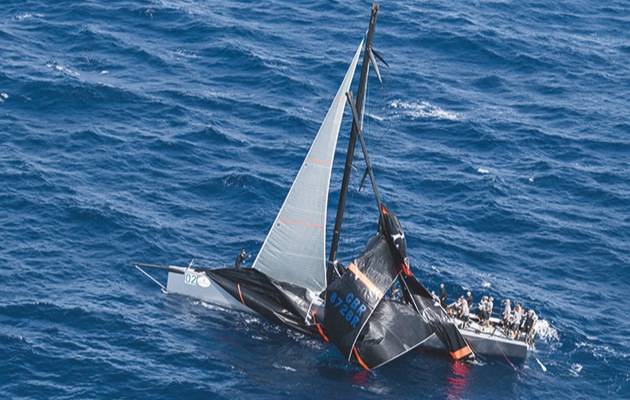Mike Golding, one of the world’s most accomplished offshore sailors, explains what has happened in the featured image of Caol Ila R during the Maxi Yacht Rolex Cup in Porto Cervo 2015
Although it is difficult to understand exactly what went wrong, we can deduce the following: prior to the dismasting the boat was on starboard and probably footing or reaching under three sails rather than sailing upwind. Bearing this in mind, it is unlikely that it is a case of the runner being missed after a manoeuvre.
Ideally, someone would have seen what broke, but if not it is important to work out what happened to help prevent failures in the future.
The weather looks ideal with perhaps 16-18 knots of wind and moderate waves, so unless there was a squall, it’s unlikely the mast was overloaded. With these conditions the sail plan looks fine so overloading seems unlikely.
The mast failed just above the D1 so it could be a mast tube compression failure where the tube simply gave way under an excessive load or perhaps failed as a result of some prior impact damage to the carbon. The starboard upper spreader is missing from the image so it’s also possible this could have failed first.
Standing rigging failures fall into two categories: cable failure or attachment failure. In the photo the fore/staysail stays remain, which leads me to suspect it is either the runner or one of the starboard intermediates, or the cap shroud.
Golding’s advice on how to recover
The first thing is to ensure the crew are OK and everyone is aboard. If anyone is hurt then that’s the priority. Assuming everyone is fine, it is important to check for any other immediate dangers, which includes assessing if anything is endangering the boat. Then it is a case of working out what can be salvaged.
It looks as though the jib and the staysail are both OK, although the process of detaching the head of the genoa would be tricky. The mainsail has peeled off the mast, but again releasing the head will be difficult.
It is important to keep the rig clear of the hull, but equally vital to do the right thing at the right time, so put a plan in place. If there’s sea room it need not be a panic.
The engine is not an option until all rigging and sails are clear of the propeller. It seems to me from the image that a lot can be salvaged – one tip at this stage is to take a lot of photos; this will help the insurers.
Be aware also, that without the mast in place the boat will roll more violently than usual, and there are also dangers from unusually loaded parts, which could fail at any moment. The team must be ultra-cautious working around the rig in particular. It may well be necessary to send a person aloft to cut or detach the sails and upper rigging.
… and how to avoid the situation in the first place
A major failure such as a dismasting is caused by either: a) operator error or b) equipment failure. Operator error could include sailing with too much sail up, a mast collision with another boat, or perhaps a simple mistake such as not setting the running backstay after a manoeuvre.
Recognising when you are pushing too hard is the racing sailor’s conflicting nightmare. My experience from my Challenge yacht days, and since then with the IMOCA 60s, is that sailing within the proper limits is ultimately faster, safer and more importantly sustainable.
The potential equipment failure list is long. It could be that something horribly simple and cheap has been missed in maintenance.
It’s not going to have been a good day for these guys, but it is important for them to come away safe and knowing exactly what has happened. It’s another learning experience and all a part of the rich tapestry of sailing.
Key points
- Carry out a headcount straight away to ensure the crew are all on board and safe.
- Check parts of the failed spar are not causing further damage to the boat.
- Assess the damage and work out what can be salvaged. Take photos of any damage for insurance purposes.
- Work promptly to clear the hull of lines and fragments of mast before firing up the engine.
Interview by Sue Pelling

MIKE GOLDING OBE (55) became known in Britain in the mid 1990s when he established the fastest westabout circumnavigation, and won the BT Global Challenge in 1996/7. Golding was the first person to sail solo non-stop round the world both eastabout and westabout. He completed three Vendée Globes and in total has done nine circumnavigations.




